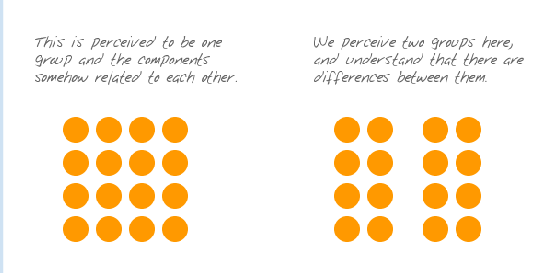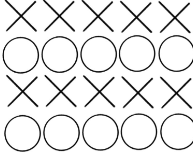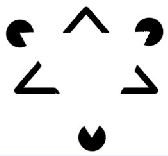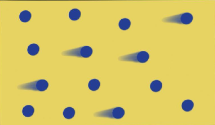psyc 100-chap. 5
1/65
There's no tags or description
Looks like no tags are added yet.
Name | Mastery | Learn | Test | Matching | Spaced |
|---|
No study sessions yet.
66 Terms
Sensation
the elementary components, or building blocks, of an experience
Perception
the collection of processes used to make a meaningful interpretation of sensations
How Do We Build an Internal Interpretation of the External World?
To make sense of the world, the brain must solve three key problems for each sensory system: Translate, Identify, Interpret
Building an Internal Interpretation of the External World: Translate
Convert external stimuli (like light or sound) into neural signals the brain can understand.
Example: sound vibrations → electrical signals in the auditory nerve.
Building an Internal Interpretation of the External World: Identify
Break down sensory input into basic components (colors, tones, textures).
These signals are sent to specialized processing areas in the brain.
Building an Internal Interpretation of the External World: Interpret
The brain organizes and combines sensory information with past knowledge to build a stable, meaningful perception of the world.
What is the function of the retina in vision?
the thin light-sensitive layer at the back of the eye that contains rods and cones, which detect light and send signals to the brain for visual processing.
- area of translation
Rods
Receptors located on the sides of the retina, highly sensitive to light, responsible for vision in dim or nighttime environments (called scotopic vision).
Located on the sides of the retina.
Very sensitive to light; used for night or dim-light vision (scotopic vision).
Do not detect color — only shades of gray.
Cones
Receptors located in the middle of the retina, called the fovea, that fire action potential in daylight and are used to process color and fine details (visual acuity).
Concentrated in the fovea (center of retina).
Function in bright light; responsible for color vision and fine detail (visual acuity).
Visual transduction
The process by which light is converted into electrical signals that the brain can interpret as sight.
Left visual field
Visual information from this field is processed by the right side of the eyes, then travels through the optic nerve and optic chiasm to the right hemisphere of the brain.
Right visual field
Visual information from this field is processed by the left side of the eyes, then travels through the optic nerve and optic chiasm to the left hemisphere of the brain.
Visual Cortex
Located in the occipital lobe, it is responsible for processing visual information.
Visual Cortex: What is Prosopagnosia?
Inability to recognize faces due to brain injury.
Trichromatic Theory
Color information is extracted by comparing activation of three different types of cone receptors in the retina: Red, Green, Blue.
Color blindness
A lack of color-associated cones resulting in an inability to distinguish specific colors.
Bottom-up processing
Processing that is controlled by the physical messages delivered to the senses.
Example:
You see an unfamiliar object and study its shape and color to figure out what it is.
(Perception starts with the raw sensory data)
Top-down processing
Processing that is controlled by one's knowledge, beliefs, and expectations about the world to interpret and organize what we see.
You quickly recognize your friend in a crowd because you expect to see them there
(Perception is guided by prior knowledge and expectations)
What did Gestalt psychologists argue?
We are born with innate organizing patterns of perception, dividing any visual scene into figure and ground.
Gestalt Principles of Organization: Law of Proximity
Objects that are close together are seen as part of the same group.
Example:
When you see a cluster of dots close to each other, you perceive them as one group instead of separate dots.

Gestalt Principles of Organization: Law of Similarity
Objects that look alike are seen as part of the same group.
Example:
Players wearing the same jersey color are perceived as being on the same team.

Gestalt Principles of Organization: Law of Closure
We tend to fill in gaps to see a complete, whole object.
A dotted circle is still perceived as a full circle.

Gestalt Principles of Organization: Law of Good Continuation
Definition: We prefer smooth, continuous patterns over abrupt changes or breaks.
Example: We see a straight line and a curved line crossing, rather than random angles.

Gestalt Principles of Organization: Law of Common Fate
Definition: Objects that move together are seen as part of a single group.
Example: A flock of birds flying in the same direction is perceived as one unit.

Gestalt Principles of Organization: The Law of Symmetry
Definition: We perceive symmetrical elements as part of the same group and as forming balanced, unified shapes.
Example: When we see two symmetrical brackets, like (), we naturally group them together as a single pair.
Recognition by Components
A theory by Irving Biederman (1987) stating that 36 geons can create over 150 million possible complex and meaningful objects.
Occlusion (interposition)
If one object partially blocks the view of another object, the object being blocked must be behind the first object.
Texture Gradient
The amount of detail in an object; the closer the object, the more detail visible.
Relative Brightness
The visual phenomenon in which closer objects appear brighter than further objects.
Motion Parallax
Objects that are closer appear to move faster than objects that are far away.
Convergence
When watching an object close to us, our eyes point slightly inward; this depth cue is effective only on short distances (less than 10 meters).
Retinal disparity
The amount of disparity (difference) between the image in the left eye and the image in the right eye; the greater the difference, the closer the object is to the viewer.
Phi Phenomenon
An optical illusion that causes one to see several still images in a series as moving.
Perceptual Constancies
The ability to perceive objects as remaining the same, even when the sensory experience of the object changes.
Sound
The physical message of the auditory system; travels in the form of a wave through air or water.
Hearing Range
People can hear from 20-20,000 Hz.
Pressure Amplitude (Loudness)
Change in sound intensity; measured in decibels (dB).
Eardrum (Tympanic Membrane)
The membrane that vibrates in response to sound entering the ear.
Cochlea
The sound processor that turns vibrations into neural impulses.
Place Theory
Different pitches are detected at specific spots on the basilar membrane in the cochlea.
High-frequency sounds → base of cochlea
Low-frequency sounds → apex (tip) of cochlea
Frequency Theory
Pitch is determined by how fast auditory neurons fire.
Faster firing = higher pitch
Slower firing = lower pitch
High-Frequency Sounds
Activate hair cells at the base of the cochlea.
Low-Frequency Sounds
Stimulate hair cells near the apex of the cochlea.
Auditory Nerve
Transmits messages to the brain; left ear → right hemisphere, right ear → left hemisphere.
Auditory Cortex
Located in the temporal lobes, areas are specialized for low or high frequencies.
Auditory Perception
The brain uses incoming information and past knowledge to create auditory perception.
How does the brain grouping of Auditory Information?
The brain groups auditory information that is similar and that occurs close in time together.
Silent Gaps in a Song
Auditory regions of the brain show activation when there were silent gaps in a song. (Top-down processing)
Sound Location
The location of a sound influences which ear will hear the sound first, providing the brain with information about the sound's location.
Intensity of Sound
The intensity of a sound may be stronger in one ear, suggesting that the sound is closer to that side of the body.
What are the three skin senses
touch
temperature
pain
How does the sense of touch (pressure) work and what is its purpose?
Pressure on the skin activates receptor cells.
Signal travels → spinal cord → somatosensory cortex (parietal lobe).
Specialized nerves detect pressure, vibration, or stretch.
Touch helps us identify object properties and locations.
Temperature
The body records and processes temperature through thermoreceptors located in the skin.
Cold Fibers
Neurons that respond when the temperature of the skin reduces.
Warm Fibers
Neurons that respond when the temperature of the skin increases.
Pain
An adaptive reaction that the body generates in response to events that are intense enough to cause tissue damage.
Nociceptors
Skin pain receptors activated by both external and internal pain.
What is the Gate-control theory?
Neural impulses generated by pain receptors can be blocked in the spinal cord by signals produced in the brain.
Gate-Control Theory: Pain Management Techniques
Rubbing injury and placing ice can close pain gates.
Drug treatments
Cognitive states can close the pain gate (positive mood)
Focusing (worry) on the pain may open the pain gate
Chemoreceptors
Receptor cells that react to invisible molecules scattered about the air or dissolved in liquids, leading to the senses of taste and smell
Chemical senses
Taste and smell are closely linked
How does the sense of smell (olfaction) work?
Smell molecules enter the nose and hit smell receptors.
Receptors send signals to the olfactory bulb in the brain.
The brain identifies the smell.
Smell is strongly linked to memory and emotion.
How does taste (gustation) work?
Five basic tastes: sweet, sour, salty, bitter, umami (savory)
Taste buds on the tongue detect taste and send signals to the brain.
Flavor = taste + smell + sight + expectations.
Past experiences affect how we perceive taste.
Babies naturally like sweet and dislike bitter.
Absolute Threshold
The level of intensity that lifts the stimulus over the threshold of conscious awareness.
Difference Threshold
The smallest detectable difference in the magnitude of two stimuli.
Weber's Law
The just noticeable difference between two stimuli is based on a proportion of the original stimulus rather than on a fixed amount of difference.
Example:
The louder the phone is the more of a volume increase you
need to notice a difference
Sensory Adaptation
The tendency for the sensory system to reduce sensitivity to a stimulus that remains constant.